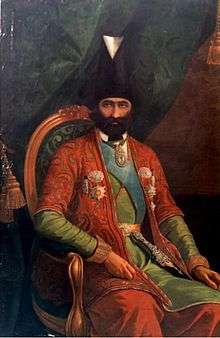Farrokh Khan
| Farrokh Khan | |
|---|---|
 Painting of Farrokh Khan | |
| Personal details | |
| Born |
1812 Kashan, Persia |
| Died |
1871 Persia |
| Children |
Mohammad Ebrahim Ghaffari Mahdi Ghaffari |
| Religion | Shia Islam |
Farrokh Khan (also spelled Ferouk Khan, Feruk Khan and Ferukh Khan), also known by his title of Amin od-dowleh,[1] was a high-ranking Persian official, and vice premier to the court of shah Fath-Ali Shah Qajar. He was also the Persian ambassador to the emperor of France, Napoleon III, and the king queen of Great Britain, Queen Victoria. The visit followed the outbreak of the Anglo-Persian War (1856-1857) between Persia and Great Britain.
Biography
Farrokh was born in 1812 to a family who belonged to the Ghaffari clan. He was the grandson of Ghazi Mo'ezz od-Din Mohammad Ghaffari, and a cousin of two painters named Abu'l-Hasan Mostafi and Abu'l-Hasan Sani od-Molk. When Farrokh was a young boy he was sent to the court of Fath-Ali Shah Qajar in Tehran. In 1833, he participated in Mohammad Mirza's siege of Herat.[1] In 1836 Mohammad Shah sent Farrokh to Mazandaran to suppress a rebellion, which he managed to accomplish. One year later, he suppressed rebellions in Isfahan and Gilan. He later participated in the siege of Herat in 1838. In 1850 Mirza Taqi Khan (later known as Amir Kabir) appointed Farrokh as the tax-collector of all the Iranian provinces. Four years laters, Farrokh was appointed by Naser al-Din Shah Qajar as his treasurer.
In May 1856, Farrokh was given the title of "Amin od-Molk".[1] In 1856, during another Iranian siege of Herat and a war with Great Britain, Farrokh was sent to the court of the French Emperor Napoleon III at Paris to negotiate with him.[2] Furthermore, he was also given the objective to negotiate with the Ottoman ruler and the British and French diplomats in Constantinople to make a peace treaty with Great Britain.[1]
Farrokh was accompanied by a suite of more than twenty persons, including councillors, dragoman, secretaries and writers. Six horses were given in present to the French Emperor, who expressed his regret about the conflict between Persia and Great Britain.[3] Negotiations led to the Treaty of Paris in March 1857, which put an end to the Anglo-Persian War.[4]
After the treaty, Farrokh Khan returned to Persia, where he became Prime Minister.[5] Farrokh also made the shah to send 42 students to Europe in order to receive a higher education, which would help in the progression of Iran.[1] In April 1859, Farrokh was given title of "Amin ol-Dowleh", and was appointed as the tutor of prince Mass'oud Mirza Zell-e Soltan. In May 1866, Farrokh was appointed as the governor of Fars in southern Iran, including the provinces of central Iran.
Farrokh Khan later died from a heart attack on 5 May 1871, and was buried in Qom.[1] His most known sons were Mohammad Ebrahim Ghaffari (1860-1918) and Mahdi Ghaffari (1865-1917).
See also
References
Sources
| Wikimedia Commons has media related to Farouk khan. |
- Gaffary, F. (1984). "AMĪN-AL-DAWLA, FARROḴ KHAN ḠAFFĀRĪ". Encyclopaedia Iranica.
- Tuttle &; Bennett (1859). Freemason's Monthly Magazine, Vol. 18. Harvard University.